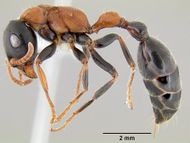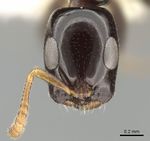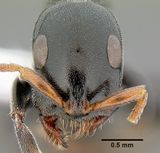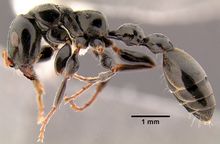Key to Tetraponera of the Oriental and Australian regions
This worker key is based on: Ward, P. S. 2001. Taxonomy, phylogeny and biogeography of the ant genus Tetraponera (Hymenoptera: Formicidae) in the Oriental and Australian regions. Invertebrate Taxonomy. 15:589-665.
Most collections of Indo-Australian Tetraponera consist of isolated workers, unassociated with sexual alates, and often lacking biological data. Our knowledge of the ecology and behavior of these ants would be enhanced if more emphasis were placed on the procurement of nest series. This would also allow the accumulation of worker-associated queens and males, whose characteristics may prove to be more reliable for delimiting species. Males are known for only about half the species (and in small sample sizes for some of these) but the available data indicate that the genitalia provide good diagnostic traits for some species and clades.
This key excludes Tetraponera vivax and Tetraponera volucris, two species known only from the queen caste.
You may also be interested in:
- Tetraponera
- Key to Tetraponera queens of the Oriental and Australian regions
- Key to Tetraponera males of the Oriental and Australian regions
1
- Head with three distinct ocelli; in dorsal view pronotal humeri appearing subangulate; head densely punctate, and lacking extensive shiny interspaces between the punctures; large species, HW 1.14-2.07 . . . . . 2
- Head almost always lacking ocelli, very rarely with two or three faint ocelli (in a few large workers of T. nigra and T. punctulata); pronotal humeri varying from narrowly to broadly rounded, but not subangulate; head usually less densely punctate and with conspicuous shiny interspaces between the punctures (always the case in species with HW > 1.1 0); size variable (HW 0.49-1.48) . . . . . 3
2
return to couplet #1
- Larger species (HW 1.62-2.07), with smaller eyes (REL2 0.35-0.37); usually bicolored, the dark head and gaster contrasting with the orange-brown mesosoma (the latter infuscated in some populations); standing pilosity common on the mesosoma dorsum, including the propodeum, MSC 20-66 (Pakistan to southern China, south to Sumatra and Java; introduced into the Seychelles) . . . . . Tetraponera rufonigra
- Smaller species (HW 1.14-1.51), with larger eyes (REL2 0.49-0.56); body unicolorous dark brown; standing pilosity sparse on the mesosoma dorsum, absent from the propodeum, MSC 3-6 (Myanmar to Vietnam, south to Palawan, Borneo, Sumatra and Java) . . . . . Tetraponera pilosa
3
return to couplet #1
- Mandible slender, with three teeth on the masticatory margin, and 1-2 denticles on the basal margin; basal margin of mandible much longer than masticatory margin; posteroventral margin of petiole in the form of a thin, ventrally protruding hood, which is distinctly separated from the helcium venter when the postpetiole is in its normal horizontal position; mesosternum densely pubescent; abdominal tergite IV sparsely pubescent, the appressed hairs separated by their lengths or more; relatively small species, HW 0.49-0.93 (allaborans-group) . . . . . 4
- Mandible more robust, with four teeth on the masticatory margin, and 0-1 denticles on the basal margin; basal margin of mandible subequal to, or shorter than, masticatory margin; posteroventral margin of the petiole closely associated with the helcium venter, although it may be flanked by ventrolateral flanges; most of the mesosternum devoid of pubescence; abdominal tergite IV usually densely pubescent; size variable, HW 0.63-1.48 (nigra-group) . . . . . 4 4
4
return to couplet #3
- Small, black species (HW 0.58-0.61, LHT 0.50-0.52), with disproportionately small eyes (REL 0.32-0.34), short scapes (SI2 0.42-0.45) and broad profemur (FI 0.47-0.48); pronotal dorsum rounding into sides, lateral margins poorly developed; mesopropodeal impression lacking a distinct metanotal plate but may be bisected by a weak transverse ridge that interrupts the longitudinally rugulate sculpture (Thailand) . . . . . Tetraponera connectens
- Size, color, scapes and profemur variable but if small (HW <0.65 and LHT <0.55) and black, then eyes larger (REL 0.35-0.41); either lateral pronotal margins better developed or mesopropodeal impression with a distinct, flattened metanotal plate . . . . . 5
5
return to couplet #4
- Mesopropodeal impression with irregular longitudinal rugulae, interrupted by a small, raised transverse welt (metanotal plate), which is bounded laterally by the metanotal spiracles and which lacks rugulate sculpture; pronotum lacking distinct lateral margins, the dorsum rounding gently into the sides, as seen in posterior view; profemur short and broad, FI 0.44-0.53; dark brown to black species . . . . . 6
- Mesopropodeal impression with irregular longitudinal rugulae, sometimes crossed at the midpoint by a broken transverse rugule, but lacking a raised metanotal plate; pronotum with more or less distinct lateral margins, which vary from sharp to blunt-edged; in posterior view pronotal dorsum meeting the sides at a sharply rounded angle; profemur usually more slender (FI 0.36-0.48); color variable . . . . . 9
6
return to couplet #5
- Median clypeal lobe subtriangular, protruding, and pointed; petiole narrow in dorsal view (DPW/MTW 0.61-0.64) (Borneo) . . . . . Tetraponera apiculata
- Median portion of clypeus broadly convex, not prominently protruding and pointed; petiole broader in dorsal view (DPW/MTW 0.65-0.73) . . . . . 7
7
return to couplet #6
- Larger species, with broad head (HW 0.82, CI 0.92) and large eyes (REL 0.42); anterior clypeal margin edentate and nonprotruding; petiole slender (PLI 0.51); mesopleuron extensively longitudinally carinulate (West Malaysia) . . . . . Tetraponera avia
- Smaller, with more elongate head (HW 0.63-0.75, CI 0.73-0.84) and smaller eyes (REL 0.35-0.39); anterior margin of clypeus with a modestly protruding and crenulate median lobe; petiole more robust (PLI 0.58-0.67); mesopleuron predominantly smooth and shining . . . . . 8
8
return to couplet #7
- Smaller species with more elongate head (HW 0.63-0.65, CI 0.73-0.75); eye larger in relation to scape length (SI3 1.19-1.21); petiole relatively slender (PLI 0.58-0.62) (Borneo, ?West Malaysia) . . . . . Tetraponera bita
- Larger species with broader head (HW 0.73-0.75, CI 0.82-0.84); eye smaller in relation to scape length (SB 1.25-1.30); petiole shorter and more robust (PLI 0.63-0.67) (West Malaysia) . . . . . Tetraponera brevis
9
return to couplet #5
- Small species (HW 0.60-0.64), with short scapes (SI 0.52-0.57, SI2 0.41-0.44); median clypeal lobe bidentate; pronotum relatively narrow (PrWM/MTW 1.14-1.21), with sharp, subparallel margins, as seen in dorsal view, and appearing rather flattened in posterior view; profemur broad (FI 0.42-0.48) (China, Vietnam) . . . . . Tetraponera microcarpa
- Scapes longer (SI 0.57-0.68, SI2 0.45-0.57); median clypeal lobe usually with three or four teeth, or lacking teeth altogether, rarely with a pair of well developed teeth; size variable but if falling within the above range then usually the pronotal margins are soft-edged and convex in dorsal view and the profemur is more slender; dorsal surface of pronotum more convex in posterior view . . . . . 10
10
return to couplet #9
- Larger species (HW 0.62-0.93, usually >0.70); body predominantly black, although petiole, postpetiole and limb appendages may be lighter in color; propodeum typically low and broad, such that PDI 0.91-1.09; in one rare aberrant morph with HW >0. 79 the propodeum is inflated and prominently raised; pronotal margin varying from sharp- to soft-edged, and maximum width of the pronotum generally occurring below the margin (widespread and highly variable species, distributed from India to southern China, south to New Guinea and northern Australia) . . . . . Tetraponera allaborans
- Smaller species (HW 0.49-0.79), color variable but often with at least the postpetiole-and sometimes most of the body-yellow or orange-brown; if HW >0.65 then body mostly dark brown to black but propodeum notably tall (lateral view) and slender (posterior view), such that PDI 1.12-1.24; pronotal margin usually relatively soft-edged and occurring at the point of maximum width of the pronotum . . . . . 11
11
return to couplet #10
- Small species (HW 0.64) with large eyes (REL 0.42); propodeum conical in profile, the prominent apex located far forward, so that the short inclined dorsal face of the propodeum rounds into a much longer, sloping declivitous face; petiole short and broad (PWI 0.54, PL/LHT 0. 72), subtriangular in profile and without a well differentiated anterior peduncle; castaneous brown (Borneo) . . . . . Tetraponera conica
- Eyes smaller (REL 0.34-0.41); propodeum not conical in profile, the dorsal face convex and rounding gradually into a steep declivitous face of approximately the same length; petiole longer and narrower (PWI 0.38-0.54, PL/LHT 0.83-0.98), a differentiated anterior peduncle and posterior node evident in profile; size and color variable (modesta-complex) . . . . . 12
12
return to couplet #11
- Small species (HW 0.53-0.61), with a relatively short, high petiole (PLI 0.60-0.68, PWI 0.46-0.54, PLISL 1.09-1.19); body and legs dark to medium brown (pronotum, petiole and postpetiole may be lighter in color); standing pilosity tending to be rather common, with 8-10 long setae often visible in profile on the promesonotum (but sparse or abraded in some specimens) (Thailand, West Malaysia, Borneo, Sumatra) . . . . . Tetraponera crassiuscula
- Petiole more slender (PLI 0.45-0.59, PWI 0.38-0.48, PL/SL 1.20-1.41); standing pilosity relatively sparse, 1-2 pairs of long erect setae visible in profile on the pronotum, none on the mesonotum; size (HW 0.51-0.79) and color variable . . . . . 13
13
return to couplet #12
- Head, mesosoma, and most of gaster black or dark brownish black, the other body parts variable in color, postpetiole and tibiae often a contrasting lighter yellow or orange-brown; larger species, on average (HW 0.54-0.79, usually greater than 0.60) (Malay Peninsula south and east to Lombok, Sulawesi and the Philippines) . . . . . Tetraponera extenuata
- Body color predominantly yellow- or orange-brown, the gaster sometimes partially or wholly dark brown; problematic specimens with more darkened head and mesosoma also occur, see discussion in text; smaller species (HW 0.51-0.64) (northeast India to China, south to New Guinea) . . . . . Tetraponera modesta
14
return to couplet #3
- Larger species (HW 0.95-1.48), with long legs (LHT/HL 0.80-0.97); standing pilosity common, MSC 6-71 (usually >10) and CSC 10-40, the cephalic hairs scattered over the dorsal surface of the head and often grading into shorter, suberect pubescence; mesopropodeal impression flanked laterally by raised prominences (containing the metanotal spiracles) but otherwise more or less open, not bounded by lateral ridges that enclose a pit-like depression (a shallow pit present in T. binghami) . . . . . 15
- Smaller species, on average (HW 0.63-1.44); if HW >0.92, then standing pilosity less common (MSC 0-22, CSC 0-4) and the sparse cephalic hairs arranged in pairs on the dorsum of the head, distinct from the much shorter, appressed pubescence; legs generally shorter (LHT/HL 0.58-0.86, rarely >0.80); mesopropodeal impression partly or entirely flanked laterally by raised ridges that enclose a pit-like depression . . . . . 18
15
return to couplet #14
- Head elongate (CI 0.70-0.77) and petiole very slender (PLI 0.34-0.43) . . . . . 16
- Head broader (CI 0.76-0.94, usually >0.80); petiole shape variable but if CI <0.80 (a few individuals of T. nigra) then petiole more robust (PLI >0.50) . . . . . 17
16
return to couplet #15
- Smaller species (HW 0.96-0.97), with relatively large and conspicuous eyes (REL 0.40-0.42); profemur short and broad (FI 0.45-0.47) (Borneo) . . . . . Tetraponera buops
- Larger species (HW 1.06-1.27), with relatively smaller eyes (REL 0.25-0.30); profemur slender (FI 0.37-0.40) (India and Nepal, east to southern China, south to West Malaysia) . . . . . Tetraponera binghami
17
return to couplet #15
- Petiole long and slender, PLI 0.38-0.47, PL/HL 0.74-0.92; mesosoma, petiole and postpetiole, when viewed in profile, with scattered standing pilosity accompanied by, and often grading into, a dense mat of shorter suberect hairs, present on all dorsal surfaces; (north-east India to China, south to Sumatra, Java, Borneo and Palawan) . . . . . Tetraponera attenuata
- Petiole shorter and higher, PLI 0.52-0.64, PL/HL 0.57-0.72; mesosoma, petiole and postpetiole, when viewed in profile, with standing pilosity and underlying suberect pubescence variably developed (and variably distinguishable), but at least the promesonotum and the anterior peduncle of petiole lacking a dense mat of short suberect hairs; (Pakistan to Thailand, south to Borneo and Java) . . . . . Tetraponera nigra
18
return to couplet #14
- Petiole with a pair of acute, posteroventral teeth, formed from ventrolateral extensions of the petiolar sternite; pronotum with dense punctate sculpture on its anterior quarter which contrasts with the shiny (and less densely sculptured) posterior half of head and with the more sparsely punctate posterior regions of the pronotum; scapes shorter than eye length (SI3 0.83-0.98) . . . . . 19
- Petiole lacking a pair of posteroventral teeth; pronotal sculpture variable but punctures more evenly distributed, not concentrated solely on the anterior quarter (although they may be sparse medially) and usually not occurring in a density that contrasts strongly with that of the posterior half of the head; scapes longer than eye length (SI3 1.02-1.55) . . . . . 22
19
return to couplet #18
- Head elongate (CI 0.73-0.77); petiole very slender (PLI 0.43-0.49) (Thailand, West Malaysia) . . . . . Tetraponera notabilis
- Head broader (CI 0.78-0.90); petiole much shorter (PLI 0.60-0.79) . . . . . 20
20
return to couplet #19
- Larger species (HW 0.83-0.95), with dense pubescence on postpetiole and abdominal tergite IV, which obscures the sheen of the integument; frontal carinae more widely separated (MFC 0.12-0.15, FCI 0.15-0.16) (Borneo, Thailand) . . . . . Tetraponera nodosa
- Smaller species (HW 0.63-0.83), pubescence generally sparser on postpetiole (hairs separated by about their lengths) and varying from sparse to moderately dense on abdominal tergite IV, not obscuring the sheen of the integument; frontal carinae less widely separated (MFC 0.07-0.10, FCI 0.10--0.14) . . . . . 21
21
return to couplet #20
- Short standing pilosity (0.03--0.05 mm in length) common on most body surfaces, including sides of head, dorsum of head (CSC 15-25), and mesosoma (MSC 30-56) (northern Australia) . . . . . Tetraponera nixa
- Standing pilosity much less common on head (CSC 0-6), absent or sparse on the sides when head is observed in full-face view; standing hairs generally sparse on mesosoma (MSC usually <10), but occasionally quite common; if MSC >20 then some hairs relatively long (0.1 0-0.20 mm in length) (India to southern China, south to northern Australia) . . . . . Tetraponera nitida
22
return to couplet #18
- Mesopropodeal impression flanked more or less entirely by lateral ridges, so that the pit-shaped depression extends to the posterior margin of the mesonotum; species found east of Wallace's line (Australia, New Guinea, and adjacent islands) . . . . . 23
- Mesopropodeal impression with flanking ridges much reduced or lacking anteriorly, so that the pit-shaped depression is separated from the posterior margin of the mesonotum by an open, transverse strip of integument, with longitudinally rugulate sculpture; species found west of Wallace's line (India to the Philippines, Borneo, Sumatra and Java) . . . . . 28
23
return to couplet #22
- Petiole short and very broad (PL/HW 0.57-0.59; PWI 0.79-0.88); postpetiole about 1.4x broader than long; frontal carinae widely separated (FCI 0.19-0.20) (Australia) . . . . . Tetraponera tucurua
- Petiole longer and less broad (PL/HW 0.62-0.96; PWI 0.33-0.70); postpetiole approximately as long as, or longer than, broad; frontal carinae less widely separated (FCI 0.12-0.19) . . . . . 24
24
return to couplet #23
- Posterior half of petiolar sternite flat or weakly convex in profile; petiole relatively slender (PLI 0.37-0.61, PWI 0.33-0.57); eyes larger (REL 0.36-0.45); punctures on head between compound eyes relatively coarse, mostly 0.010-0.020 mm in diameter; propodeum somewhat elevated (PDI 1.10-1.34), its dorsal face usually convex in profile, inclined downward posteriorly, and grading insensibly into declivitous face . . . . . 25
- Posterior half of petiolar sternite with prominent ventral protrusion; petiole usually more robust (PLI 0.57-0.80, PWI 0.50-0.70) and eyes tending to be smaller (REL 0.30-0.41); punctures on head between compound eyes finer, mostly 0.005-0.015 mm in diameter; propodeum lower in profile (PDI 1.00-1.19), its dorsal usually flatter and more strongly differentiated from the declivitous face . . . . . 27
25
return to couplet #24
- Head densely punctate, opaque; larger species (HW 0.94-1.04, LHT 0.84-1.00), with long legs and scapes (LHT/HL 0.79-0.86; SI2 0.53--0.55) (New Guinea) . . . . . Tetraponera atra
- Head less densely sculptured, the punctures separated by about their diameters and the interspaces shiny; smaller species (HW 0.75--0.94; LHT 0.63-0.78), with shorter legs and scapes (LHT/HL 0.65-0.74; SI2 0.43-0.50) . . . . . 26
26
return to couplet #25
- Frontal carinae widely separated (FCI 0.17-0.19) and eyes relatively small (REL 0.36-0.39, REL2 0.41-0.45), such that MFC/EL 0.38--0.45; pronotum slender, as seen in dorsal view (PrWM/MTW 1.04-1.16); petiole relatively short and broad (PLI 0.58-0.61, PWI 0.55-0.57) (New Guinea) . . . . . Tetraponera mimula
- Frontal carinae less widely separated (FCI 0.12-0.16) and eyes larger (REL 0.40-0.45, REL2 0.47-0.53), such that MFC/EL 0.25-0.30; pronotum slightly to strongly expanded laterally (PrWM/MTW 1.15-1.37); petiole shape variable but generally longer and more slender (PLI 0.45-0.59, PWI 0.40-0.49) (New Guinea and adjacent islands; northern Australia) . . . . . Tetraponera laeviceps
27
return to couplet #24
- Small species (HW 0.73-0.81); petiole with short anterior peduncle and large globose node, with steep anterior and posterior faces (FW /PH 0.51-0.62); punctures on head and pronotum mostly very fine, about 0.005 mm in diameter (New Guinea, northern Australia) . . . . . Tetraponera rotula
- Larger species (HW 0.80--1.44), with less globose petiolar node, the anterior and posterior faces more gently sloping (FW/PH 0.60-0.88); punctures on head and mesosoma mostly larger, approximately 0.010-0.015 mm in diameter (New Guinea, Australia) . . . . . Tetraponera punctulata
28
return to couplet #22
- Standing pilosity common on head and mesosoma (CSC 18-28, MSC 26-54), including mesonotum and propodeum . . . . . 29
- Standing pilosity sparse on head and mesosoma (CSC 2-4, MSC 1-5), absent from mesonotum and propodeum . . . . . 30
29
return to couplet #28
- Eyes large (REL 0.41-0.44); lateral pronotal margin sharp-edged; appressed hairs present in moderate density on abdominal tergite IV, in addition to scattered standing hairs (India, West Malaysia) . . . . . Tetraponera aitkenii
- Eyes smaller (REL 0.33-0.36); lateral pronotal margin not well developed; abdominal tergite IV with abundant, short standing pilosity but appressed hairs very sparse and inconspicuous (Borneo) . . . . . Tetraponera polita
30
return to couplet #28
- Eyes larger (REL2 0.51-0.56); profemur shorter (FL/HL 0.53-0.62, EL/FL 0.74-0.82); petiolar node usually with a short, steep anterior face and much longer, more shallowly inclined posterior face (Borneo, Palawan) . . . . . Tetraponera inversinodis
- Eyes smaller (REL2 0.44-0.48); profemur longer (FL/HL 0.60-0.67, EL/FL 0.60-0.66); anterior face of petiolar node usually not much steeper than posterior face (Malay Peninsula south and east to Sumatra, Java, Borneo and the Philippines) . . . . . Tetraponera difficilis

















































